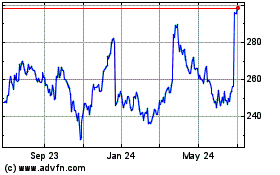Texas Bombs Show FedEx, UPS Face Tough Task Preventing Attacks
March 20 2018 - 3:14PM
Dow Jones News
By Paul Ziobro
Millions of packages pass through FedEx and UPS facilities on a
typical day, making it hard to prevent the type of explosion that
rocked a FedEx Corp. sorting center in Texas early Tuesday.
The massive volumes that move through these delivery networks
makes screening each package for explosives or other hazardous or
illegal materials impractical, industry consultants said. FedEx
last year processed about 12 million pieces a day, while United
Parcel Service Inc. handles more than 20 million a day.
"The costs of it and the practicality of it would be so
outrageous," said Satish Jindel, president of SJ Consulting Group
Inc., a parcel-industry research firm. "If someone wants to be
destructive, they can do it."
FedEx does X-ray some packages that travel through its system
and has dog-sniffing teams that conduct checks, a former FedEx
executive said. FedEx also uses algorithms that can trigger further
inspections based on a package's dimensions and delivery locations,
this person said. Most of the screenings are for drugs, but they
also are used to try to find explosives and other materials.
On Tuesday, the Federal Bureau of Investigation said an
explosion at the facility outside San Antonio may be linked to a
recent spate of bombings in Austin.
In addition, police said they were responding to reports of a
suspicious package at another FedEx facility in Austin.
FedEx confirmed that a single package exploded at a FedEx Ground
sortation facility, and one employee was being treated for minor
injuries. The company said it was working closely with law
enforcement on the investigation.
"We don't disclose the specifics of our advanced security
measures, but they are designed to protect the safety of our
people, customers and communities, and to assist law enforcement as
appropriate," a FedEx spokesman said.
UPS declined to discuss its security measures "in order to
maintain their effectiveness," a spokesman said, adding that the
company is cooperating with law enforcement.
The U.S. Postal Service, which delivers more packages than any
other carrier, says it uses a combination of technology, screening
protocols and employee training to protect its network. The agency
has response teams that investigate suspicious parcels. They are
trained to identify signs of suspicious mailings and have portable
equipment like X-ray machines at their disposal.
"Any reports of suspicious mailing are taken very seriously, as
they may impact the safety of postal employees and disrupt the
processing of mail, " a USPS spokesman said. The Postal Service
delivers nearly half a billion mail pieces daily.
Write to Paul Ziobro at Paul.Ziobro@wsj.com
(END) Dow Jones Newswires
March 20, 2018 14:59 ET (18:59 GMT)
Copyright (c) 2018 Dow Jones & Company, Inc.
FedEx (NYSE:FDX)
Historical Stock Chart
From Mar 2024 to Apr 2024

FedEx (NYSE:FDX)
Historical Stock Chart
From Apr 2023 to Apr 2024
